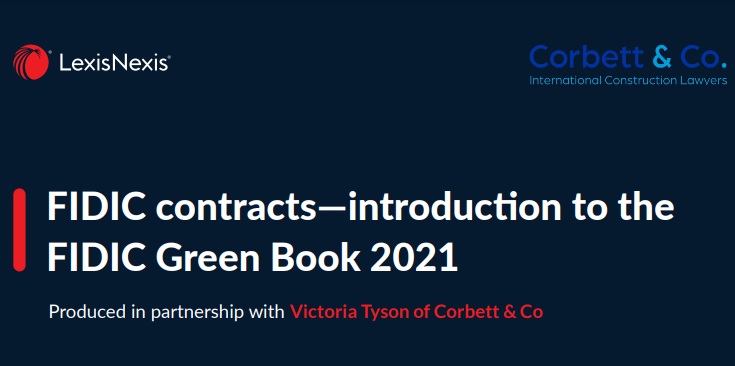FIDIC 2022 Reprints: 10 Key Areas Of Change In The FIDIC Red Book 2017
FIDIC ‘launched’ the FIDIC 2022 reprints at the FIDIC International Construction Users’ Conference 2022, in London. The reception to the changes was mixed – some embraced the clarity; others questioned the significance and cost. This article draws your attention to 10 of the key areas of change in respect of the FIDIC Red Book 2017 including the definition of Claim, matters to be agreed or determined, the definition of Dispute and Exceptional Events.
FIDIC contracts—introduction to the FIDIC Green Book 2021
This Practice Note is an introduction to the FIDIC Green Book 2021 (the Short Form of Contract). It is not a fully detailed clause-by-clause commentary. This article was first published by LexisPSL
Escalating construction costs under FIDIC: is Sub-Clause 13.8 an answer?
Construction costs are escalating. Under existing contracts, an employer will not want to pay more for the works. But forcing a contractor to perform works that are unprofitable or causing a massive loss is unlikely to be in the best interests of the project. It may result in the insolvency of the contractor forcing the employer to abandon the contract or re-let it, probably at a premium. Is a mechanism for cost adjustment, such as FIDIC 1999 Sub-Clause 13.8 [Adjustments for Changes in Costs], an answer?
The Dangers of Employer Set Off in your FIDIC Contract: Suspension and Termination
Unfortunately, under the FIDIC Red and Yellow Books 1999, the right of an Employer to set off from an amount already certified in a Payment Certificate but unpaid is inexplicit. Once the Employer has a Sub-Clause 3.5 determination, it may ask the Engineer to deduct the amount determined from the next Payment Certificate. This is clear. But rather than rely on the Engineer, can the Employer instead, itself, deduct by way of set off from an amount already certified in a Payment Certificate but unpaid? This is not clear.
Changing Tack
A contract may require a party giving notice of a claim to specify the contractual or legal basis of that claim in the notice (or the supporting particulars). What if that party states a contractual or legal basis for the claim but later (perhaps with the benefit of additional information or because of advice from its lawyers) changes its mind or wants to include further contractual or legal bases? This was considered by the Hong Kong Court of Appeal in Maeda Corporation and China State Construction Engineering (Hong Kong) Limited v Bauer Hong Kong Limited [2020] HKCA 830. It found that a subcontractor could not change the contractual basis for its claim once the time period for providing such notice had expired. What, if any, impact will this decision have on the FIDIC forms of contract?
FIDIC’S Golden Principles – holding back the tide?
FIDIC is concerned about its image. It says that heavily amending the FIDIC forms of contract impacts upon the FIDIC brand and that this is damaging FIDIC’s reputation. It seeks to address this with the introduction of five Golden Principles. But the Golden Principles are merely aspirational; they are not binding and have no contractual effect. Does this render them a pointless gesture ‘trying to hold back the tide’?
FIDIC 1999 Books – Commentary on Clause 14
Clause 14 deals with all aspects of payment. It also deals with the Statement at Completion, the Final Payment Certificate, Discharge and Cessation of the Employer’s Liability. The Clause provides that this is a re-measurement contract and that the quantities stated in the Bill of Quantities are estimated. There is provision for an advance payment to be made to the Contract. Applications for Interim Payment Certificates are made monthly and these must be supported by documents and a report on progress. Unless the amount assessed is less than the minimum amount set out in the Appendix to Tender, the Engineer has 28 days to issue an Interim Payment Certificate, which states the amount the Engineer fairly determines to be due. The Employer thereafter has an obligation to pay the amount certified, in the currencies named in the Appendix to Tender. In the event that payment is not received the Contractor can claim financing charges compounded monthly. Fifty per cent of the retention monies are paid when the Taking-Over Certificate is issued. Where there are Sections then a proportion is paid. The balance of retention is paid on the expiry of the latest Defects Notification Period or, where there are Sections, a proportion at the expiry of the Defects Notification Period for that Section. Within 84 days of receiving the Taking-Over Certificate the Contractor submits a Statement at Completion. This must include an estimate of all sums which the Contractor considers due. Within 56 days of receiving a Performance Certificate, the Contractor submits a Final Statement. The Contractor must also submit with the Final Statement a written discharge which confirms that the total of the Final Statement represents full and final settlement of all moneys due. The Engineer then issues to the Employer a Final Payment Certificate. The Contract states that the Employer shall have no liability to the Contractor except to the extent that the Contractor has included an amount expressly for that matter in the Final Statement and also the Statement at Completion.
FIDIC 1999 Books – Commentary on Clause 3
Clause 3 deals with the duties and obligations of the Engineer and his assistants. Sub-Clause 3.1 deals with the role and duties of the Engineer. The Engineer is deemed to act for the Employer. The Engineer has no authority to relieve the Contractor of his duties, obligations or responsibilities under the Contract; nor can the Engineer amend the Contract. Under Sub-Clause 3.2 the Engineer can delegate authority to any assistants; however, the Engineer cannot delegate the responsibility to make Determinations. Under Sub-Clause 3.3 the Engineer may issue instructions or modified Drawings at any time, which are necessary for the execution of the Works. If the instruction constitutes a Variation, then it is dealt with under Clause 13 [Variations and Adjustments]. The Contractor is required to comply with any instruction given by the Engineer or delegated assistant. Sub-Clause 3.4 deals with the replacement of the Engineer. The Employer must not replace the Engineer with someone against whom the Contractor raises reasonable objection. Sub-Clause 3.5 deals with Determinations. When making a Determination the Engineer should consult with each of the Parties and, if agreement cannot be reached, make a fair determination in accordance with the Contract, taking due regard of all relevant circumstances. Both Parties are required to give effect to any Determination unless, or until, it is revised under Sub-Clause 20.1 [Claims, Disputes and Arbitration].
FIDIC 2017 Books – Clause 16 – Termination by Contractor
The main changes in Clause 16 are the new grounds for suspension and termination: Non-compliance with a final and binding Engineer’s Determination and binding or final and binding DAAB decision, to the extent that such failure constitutes a “material breach” of the Employer’s obligations under the Contract. (Sub-Clauses 16.1(d) and 16.2.1(d)). What constitutes a “material breach” is likely to be the subject of many disputes (see the commentary on Clause 15). Non-receipt of a Notice of the Commencement Date under Sub-Clause 8.1 [Commencement of Works] within 84 days after receiving the Letter of Acceptance. (Sub-Clauses 16.2.1(f)). This is development to ground (h) in the FIDIC Pink (MDB) Book which states: “the Contractor does not receive the Engineer’s instructions recording the agreement of both Parties on the fulfilment of the conditions for the Commencement of the Works under Sub-Clause 8.1 [Commencement of Works]”. It protects the Contractor from the financial consequences of fluctuations in the rates and prices during an extended delay to the start of the Works, although the Contractor ould be entitled to damages for breach of contract in any event. More importantly, it gives the Contractor loss of profit on the entire project. Engagement in corrupt, fraudulent, collusive or coercive practice at any time in relation to the Works or to the Contract. (Sub-Clauses 16.2.1(j).) This introduces parity between the Employer and Contractor. The wording is identical to that under Sub-Clause 15.2.1(h). In the FIDIC 1999 editions, the Employer was entitled to terminate if the Contractor gave or offered an inducement or reward etc. but there was no recipricol arrangement.
FIDIC 2017 Books – Clause 15 – Termination by Employer
The main changes in Clause 15 are the new grounds for termination: Non-compliance with a final and binding Engineer’s Determination (Sub-Clause 15.2.1(a)(ii)) and a binding or final and binding DAAB decision (Sub-Clause 15.2.1(a)(iii)) to the extent that such failure constitutes a “material breach” of the Employer’s obligations under the Contract. Maxing out the Delay Damages (Sub-Clause 15.2.1(c)). There is no requirement for the Delay Damages to have been actually deducted. It is not clear what the position would be if the Contractor claims an EOT and it is granted by the DAAB or arbitrator after termination so that the Delay Damages are reduced below the cap. Would the termination then be unlawful?
FIDIC 2017 Books – Clause 3 – The Engineer
The main changes: Employer’s consent and neutrality The main changes in Clause 3 are the express provisions in Sub-Clause 3.2 [Engineer’s Duties and Authority] that the Engineer is not required to obtain the Employer’s consent before the Engineer exercises its authority under Sub-Clause 3.7 [Agreement or Determination], and that the Engineer must act “neutrally” when exercising its duties under Sub-Clause 3.7 [Agreement or Determination]. Dictionary definitions suggest that “neutrally” is similar in meaning to the words “independently” or “impartially” found in the FIDIC Red Book 4th edition and the FIDIC Yellow Book 3rd edition. However, the drafting committee believe that by using a different word it will avoid the difficulties raised in the interpretation of independently or impartially in the earlier editions. This remains to be seen. The intention is that “the Engineer treats both Parties even-handedly, in a fair minded and unbiased manner”.
Penalty Clauses Down Under
Whilst it is widely understood that the law on liquidated damages differs considerably between common law and civil law jurisdictions, there are also differences within common law jurisdictions which are sometimes overlooked. This article summarises the recent developments to the law on penalties in England and Wales, as reported by Steve Mangan in May 2016[1], and compares them with the developments to the law on penalties in Australia.
The Employer’s Agent
The Engineer is deemed to act for the Employer and is essentially the Employer’s agent under the FIDIC Red Book 1999. He is not a wholly impartial intermediary, unless such a role is specified in the Particular Conditions, and there is no general obligation under the FIDIC Red Book 1999 for the Engineer to act independently or impartially. However, when he is required to make a determination under Sub-Clause 3.5, he is obliged to make it a fair determination and when he is obliged to issue an Interim Payment Certificate under Sub-Clause 14.6, or a Final Payment Certificate under Sub-Clause 14.13, he must fairly determine the amount due.
Murphy’s Law
Earlier this year, the English High Court considered a heavily amended FIDIC Yellow Book 1999. Whilst the case is specific to the particular contractual amendments it is worth review. The case is J Murphy & Sons Ltd v Beckton Energy Ltd. It proceeded in court and on an expedited basis as a matter of some urgency because a bond was about to be called for non-payment of delay damages. The Contractor claimed the call would affect his commercial reputation, standing and creditworthiness, and may well need to be disclosed in future tenders. He had not paid the delay damages because there had been no agreement or determination of the entitlement to such by the Engineer under Sub-Clauses 2.5 and 3.5.
Frozen Out
What relief does FIDIC provide when bank accounts are frozen as a result of war, hostilities, rebellion, terrorism etc.? Maybe not as much as you think. Tensions in Africa and the Middle East have seen the implementation of numerous international financial sanctions. While these sanction regimes vary in execution and enforcement they often freeze assets and prevent financial transactions. These restrictions may impact on the Employer’s performance of its payment obligations under the Contract. This can have serious consequences where the Contractor is entitled to suspend or terminate on notice for non-payment. Many parties automatically assume that financial sanctions will be recognised as force majeure. However, this may not be the case.
Employers Beware
How important is it for an Employer to give a Sub-Clause 2.5 notice of a set-off or cross-claim under the FIDIC Red Book form of contract? Very, according to the Privy Council in NH International (Caribbean) Limited v National Insurance Property Development Company Limited . It found that: o Sub-Clause 2.5 applies to any claims the Employer wishes to make. o The Employer must make such claims promptly and in a particularised form. o Where the Employer fails to raise a claim as required, the back door of set-off or cross-claims is firmly shut. The case also serves as a warning to Employers who take a relaxed view towards their obligation under Sub-Clause 2.4 to provide reasonable evidence of the financial arrangements they have made and are maintaining to pay the Contract Price. It doesn’t matter how wealthy or important the Employer is (it may be a Government, company or individual with very substantial funds) detailed financial information must still be provided.
Indemnity Costs – you’ll be lucky! Interim Payment of Costs – definitely maybe
Even if a claimant has achieved complete success in litigation, it remains exceptionally difficult to recover legal costs on an indemnity basis, as this case demonstrates. Costs will most likely be recovered on the standard basis – at least in the absence of bad conduct during the litigation itself. This case also indicates that the court will generally limit an interim payment of costs to two-thirds of an approved costs budget.
Light at the end of the tunnel? Gibraltar dispute reviews key FIDIC Yellow Book provisions
As disputes under the FIDIC forms of contract are normally resolved in private Dispute Adjudication Board (“DAB”) proceedings or confidential arbitration proceedings, reported FIDIC cases are rare and often of considerable precdential value either formally or informally. In this article, originally published in The International Construction Law Review, Corbett & Co. Director Victoria Tyson considers one such recent decision which was transferred from the Gibraltar courts.
Tunnel Vision: The English High Court Considers the FIDIC Yellow Book
The English Court considers termination and notice provisions under the FIDIC Yellow Book 1999. How are clause 15.1 notices to correct limited? Do termination events have to be repudiations? Is it fatal to serve notice of termination on the ’wrong’ address? When does the 28-day period under clause 20.1 start to run? Mr Justice Akenhead offers guidance to the industry.














